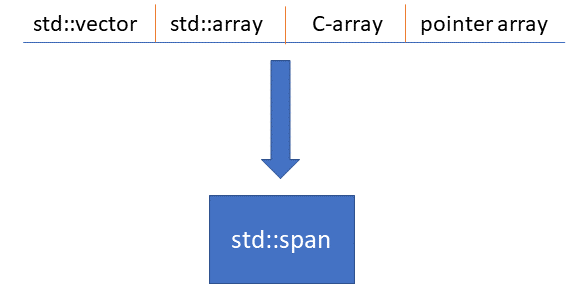Definition
Available in C++20, std::span is a view of a contiguous sequence of objects. It is a struct like:
struct span<T>{
T* pointer; // start of sequence
size_t size; // size of sequence
}
with many useful functions to access and modify data.
Compiler
To compile examples here, I use GCC 10.2 with flag -std=c++20.
Basics
span interface can attach to a C-array:
#include<span> // remember header
int main(){
int a[2]={4,3};
std::span<int> s = a;
std::cout<< s[0] <<s[1];// 4 3
return 0;}
to a dynamic pointer array:
int* a = new int[2]{8, 8};
std::span<int> s{a, 2}; // size=2
to an array:
std::array<int,2> a = {5,6};
std::span<int> s = a;
to a vector:
std::vector<int> a = {1,1};
std::span<int> s = a;
and to a part of array or vector:
std::vector<int> v = {1,2,3,4};
std::span<int> s{v.data()+2,2};
std::cout<< s[0]<<s[1]<<'\n'; // 3 4
The compiler can automatically deduce the type of a span at initialization, so this is correct:
std::vector<int> a = {1,1};
std::span s = a; // span<int>

Member functions
Similiar to standard containers, span has many useful functions that facilitate working with a sequence.
For a span like:
std::vector<int> v = {1,2,3,4};
std::span s = v;
We can traverse items with range-base loop:
for (auto& item:s)
std::cout<<item;
Read or write elements:
auto a = s.front(); // first element of sequence
auto b = s.back(); // last element of sequence
auto c = s[2]; // access via []
auto d = s.data(); // pointer to first element
Check the size:
auto e = s.size();
bool f = s.empty();
Get iterators:
auto g = s.begin(); // iterator to begining
auto h = s.end();// iterator to end
Subspan
A subspan is a span made of another span. The subspan is shorter or the same size as the primary span. For example, for a span
std::vector<int> v = {1,2,3,4,5,6};
std::span s = v;
we can get a span for the first 3 items:
auto s1 = s.first(3); // {1, 2, 3}
last 2 items:
auto s2 = s.last(2); // {5,6}
or an arbitrary span:
// subspan(offset, count)
auto s3 = s.subspan(2, 3); // {3,4,5}
If the count is not given, subspan will be from offset to the end:
// subspan(offset)
auto s4 = s.subspan(2); // {3,4,5,6}
Don’ts
Do not change the memory of a sequence, while working with a span pointing to it.
In the example below, a vector is assigned to a span, the vector’s memory location changed, then the span reused. This causes undefined behavior:
#include <iostream>
#include <vector>
#include <span>
int main(){
std::vector<int> v = {1,2,3,4};
std::cout<< v.capacity() <<'\n'; // 4
// span defined
std::span s = v;
// target memory changed
v.push_back(5);
// undefined behaviour
std::cout<< s[0] <<'\n';
return 0;}
Note that when we push_back(5), the vector memory is deleted and a new memory in a different location is allocated to fit in the new item, 5. But span, s, is still pointing to the old memory of the vector.
For the same reason, don’t do this either:
#include <iostream>
#include <span>
int main(){
int* a = new int[4] {1,2,3,4};
// span defined
std::span s {a, 4};
// memory gone
delete a;
// undefined behaviour
std::cout<< s[0]<<'\n';
return 0;
}
Function parameter
It’s very common to pass a vector or array to a function, and the function only wants to read/write elements but doesn’t add/delete elements or deallocate the memory; that’s when span comes in handy.
See this example:
int sum(std::span<int> items){
int s = 0;
for (auto& item:items)
s+=item;
return s;
}
sum reads the items but doesn’t delete any item i.e. it doesn’t own the memory. The outer scope is responsible to pass valid memory to sum.
Now we can pass various contiguous sequences to sum:
int main(){
std::vector<int> v = {1,1,1};
std::array<int,4> a = {1,1,1,1};
int b[5]{1,1,1,1,1};
std::cout<< sum(v)<<'\n'; // 3
std::cout<< sum(a)<<'\n'; // 4
std::cout<< sum(b)<<'\n'; // 5
return 0;
}
Note that if a C-array decayed to a pointer, the size information is striped and our sum function won’t work:
int* c = new int[6]{1,1,1,1,1,1};
std::cout<< sum(c);
// Error: don't know the size of c,
// so cannot convert int* to span<int>
In this case, we can construct a temporary span and pass it to the function:
int* c = new int[6]{1,1,1,1,1,1};
std::cout<< sum(std::span{c,6}); // 6
Class member
A span can be a class member. It is an observer of a sequence of objects. The class is not responsible for managing the memory of the sequence. It can read/write the objects, but cannot delete them. The user of the class is responsible for providing a valid contiguous memory.
Static span
We can specify the size of a span to be fixed at runtime:
std::span<Type, Size>
We can directly assign a std::array but not a std::vector to a fixed span, see the example below:
#include <iostream>
#include <vector>
#include <array>
#include <span>
int main(){
int a[4] {1,2,3,4};
std::vector<int> v = {1,2,3,4};
std::array<int,4> arr = {1,2,3,4};
// static span
std::span<int,4> s = a;
// reassign
s = arr; // OK
// Error: assign span<int,4> to vector<int>
s = v;
for (auto& item:s)
std::cout<< item<<'\n';
return 0;
}
As it is shown before, if we don’t specify the size of a span, it will be dynamic during runtime.
